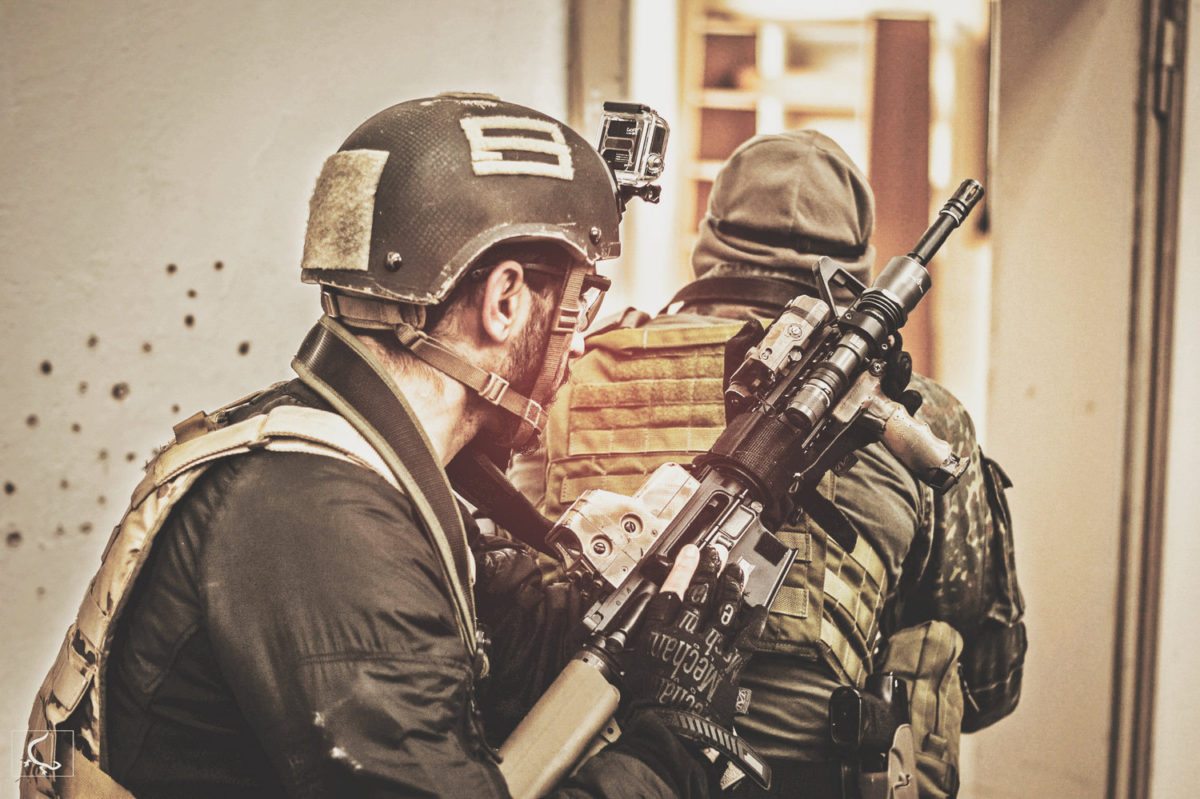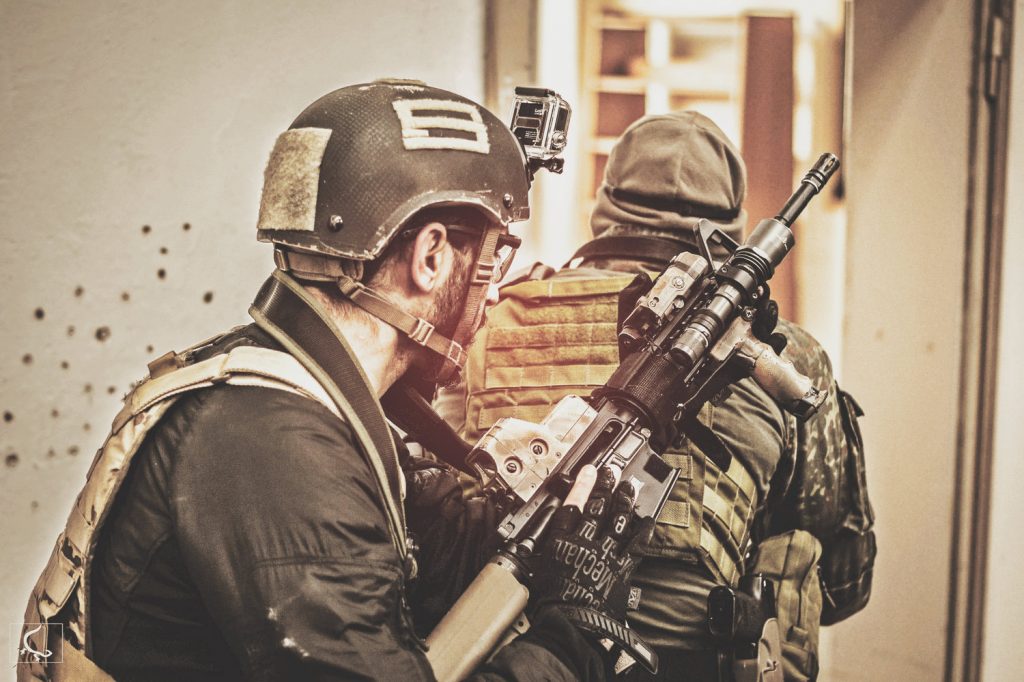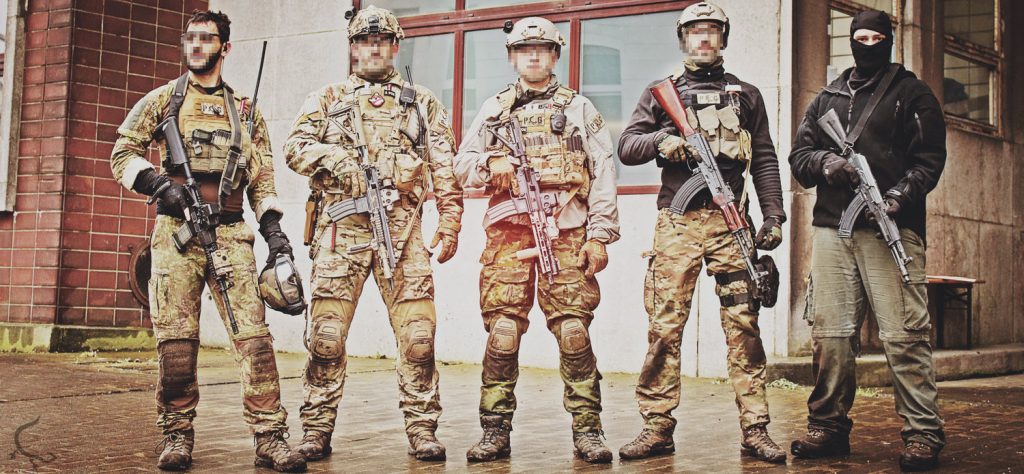In the first part of the combat stance series, we discussed the argument & further aspects of the desire to have a universal stance. In this second part in the series, we are going to focus little bit more on the bio mechanics behind it. Written by one of Project Gecko staff members with extended experience in the field of tactical fitness and physiotherapy.
Through the physiology of the muscles we know that the leg muscles creates more energy when they get slightly stretched. So similar to a sprinter getting ready at his/her starting block we also get into a slightly bended knee position to provide optimal conditions.
After we talked in the previous article about getting into optimal conditions we also want to talk about how to maintain those conditions.
Economic use of energy is key.
During long operations the soldier needs to carry all of his equipment for days. Normally the weight of the average assaulter loads out is around 25 or 30 kg. (depends on role). Due to the fact that magazines and other essentials must be reachable, most of the weight is normally in front.
So what happens now if we lean forward towards the enemy? Our lower back needs to work more to stop us from falling over. We talked about physiology of the muscle before, so we want to continue here with another small information about muscles.
Basically we can say there are 3 types of muscle fibers.
- Slow Twitch (ST) Type 1
- Fast Twitch (FT) Type 2a
- Fast Twitch (FT) Type 2b

We want to focus now only on Type 1 and Type 2b…Both have different characteristics and we want to summarize them quick.
Sadly, a reminder to the dynamic reality. (Dallas,US 2016). Note the movement and consistency.
Most muscles have both muscle types within with different distribution what leads us to the following. We can say that nearly all muscles fibers in the back musculature are Fast Twitch, so quickly exhaust able. On the other Hand is the distribution in the Quads pretty even what leads to the conclusion that the musculature in the legs can be stressed longer before they show the same symptoms. So what we want is a nearly straight back to reduce the stress on the lower back to a minimum because a physical exhaustion will lead sooner or later to a psychical exhaustion. This reduces the capability and ends in a lower ability to work under pressure.
Why risking getting hit ?
There is a motto in the German Army which says “Wirkung vor Deckung” which means effectiveness before cover.
To minimize the vulnerability they teach to stand with the plates towards the enemy so if somebody is shooting back the chance is higher they will get hit in the plate. Before we continue I want you to ask yourself a question – If somebody is punching you, is your first natural instinct to go towards or away from the threat?
So what happens now is that we try to change our deepest instincts which only show up when it comes to life threatening situations.We don’t want to get too much into the neurosciences and human behavior in a firefight but let me explain you something with the example of “Neuronal mapping”.
To learn a simple movement it takes 300-500 repetitions. To change the learned procedure it takes about 5000-7000 reps and as soon as you get tired you fall back into the old pattern.
This may come out of a sports related context but is also expressive for combat.
So all this effort only to hope the enemy is hitting you in the 310mm x250 mm plate?
We asked ourselves the question: “Why take the risk to get hit in first place, when you also could get out of line of fire first?” Additionally it is a fact that a moving target is always harder to hit which increases our chances to survive drastically.
I think it’s also the place to note, that most tactics were created in theory and a sterile environment where everything is obvious and black & white. People are training in a square area with the targets placed perfectly parallel to the back because our brain tends to like everything in an exact order.
The conclusion.
The problem is that the reality is a pure chaos and everything else is then sterile. So following the old saying “train how you fight” we try to keep the stance as usable as possible to provide optimal conditions to start a moving firefight. Having this in mind it gets clearer that there is no use in finding a perfect position to shoot in any given direction but more finding a position which gets me out of the enemy line of fire as quick and as save as possible in the first place and second gives me the opportunity to return fire as fast as possible.
Based on Bio-mechanics, Neurosciences, and Human behavior under stress and years of combat experience we designed our stance on the needs of a firefight to improve the capability of every student from the beginning. Knowing that every human is different we adapt on the individual needs of a person through trained instructors with scientific background to provide the best training progress possible.
Thank you for reading,
George.
Project Gecko is a company which specializes in the field of Tactical Training & consultant services. Their capabilities ranges from setting up Tactical courses & projects to consultant services. During their courses Gecko instructors give their participants the mental and physical tools for their personal success.
They offer a wide spectrum of programs that take place in one day classes, three-days-seminars, and events up to one week. All those programs are based and created on their knowledge which they unpack and repack in a way that will suit every participant. For Gecko the gear is just a tool and the will is the key. Gecko believes that every person who has the will, will find his place in their seminars and workshops.
The instructors behind Project Gecko are all former military personal with extended training’s and combat experience. Eliran founder of Project Gecko was born in Israel. Before he moved to Germany he served in the IDF in one of the SF units.
Find out more about Project Gecko



